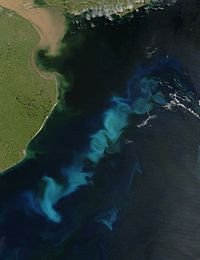
Back Alg Afrikaans Alge ALS ዋቅላሚ Amharic Algas AN طحالب Arabic শেলাই Assamese Alga AST Yosunlar Azerbaijani یوسون AZB Ылымыҡтар Bashkir



Algae (singular: alga, plural: algae) are plant-like living things. They make food from sunlight by photosynthesis. The study of algae is called phycology or algology.
The term covers different groups, and they are not all closely related. They are a polyphyletic group. The term lumps together different kinds of organisms. They are very ancient, and existed long before other types of plants. They date back to the Mesoproterozoic, over a thousand million years ago.[1] They are not quite the first type of life, because they all seem to use plastids which originate in cyanobacteria.[2]
They have in common that they are autotrophic: they use natural sources of energy and simple inorganic materials. As non-vascular plants they do not have the structure of land plants. The name "algae" is convenient but a loose term. Recently, it has become clear how different the types of algae are.[3][4]
- ↑ T.M. Gibson 2018. Precise age of Bangiomorpha pubescens dates the origin of eukaryotic photosynthesis. Geology 46 (2): 135–138.
- ↑ Keeling, Patrick J. 2004. Diversity and evolutionary history of plastids and their hosts. American Journal of Botany. 91 (10): 1481–1493.
- ↑ Fritsch F.E. 1935. The structure and reproduction of the algae. Volume I. Introduction, Chlorophyceae, Xanthophyceae, Chrysophyceae, Bacillariophyceae, Cryptophyceae, Dinophyceae, Chloromonadineae, Euglenineae, colourless Flagellata. Cambridge University Press, Cambridge.
- ↑ Stace, Clive A. (1991). Plant taxonomy and biosystematics (2nd ed.). Cambridge: Cambridge University Press. ISBN 0-521-42785-1. OCLC 963662236.
© MMXXIII Rich X Search. We shall prevail. All rights reserved. Rich X Search